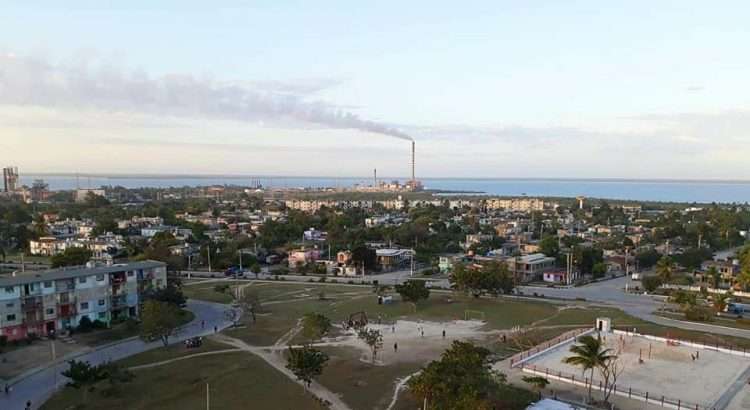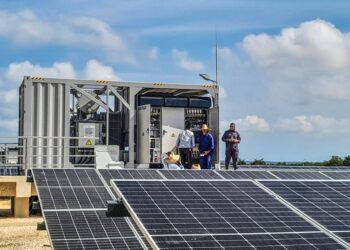Long before reaching Nuevitas, the chimney of the Diez de Octubre thermoelectric plant tells the traveler the exact location of the city. On clear days when the plant works at full capacity, its smoke is visible from more than 30 kilometers away, as a representation of the industrious spirit that in other times animated this population in the northeast of Camagüey.
A single one of the Diez de Octubre units could largely cover the 16 megawatts/hour of electricity that Nuevitas requires at its consumption peaks. The hundreds of workers at the plant and their families know it, and practically every last Nuevitas resident. However, since April — at the beginning of the current electricity crisis — until mid-July, Nuevitas and the rest of the Camagüey municipalities had their blackouts scheduled between 5:00 in the afternoon and 5:00 in the morning. On the opposite schedule, the power cuts corresponded to the main city.
Under this two-block scheme, the province aimed to cut its consumption in half, from 150 to 75 megawatts/hour.
“The twelve hours of blackout were not always met, especially on weekends, but 8 or 10 hours without power are enough to do away with any family plans. Much more so if they are in the afternoon and at night,” a Nuevitas resident in the “micros” (microdistricts), the district of buildings that went up in the 1980s to house industrial and port workers, told me. Many of her neighbors have spent months alternating the torrid nights without electricity with the demanding work shifts at the “thermo.”
Trying to respond to popular dissent, in July the Camagüey electricity enterprise implemented a new blackout schedule, with two six-hour blackouts for the main city (between 5:00 and 11:00 a.m., and 5:00 and 11:00 p.m.) and the municipalities (from 11:00 to 5:00 at both times). The 12 hours of daily disconnections for each block should be enough to continue halving the province’s electricity consumption and for night blackouts not to occur only in the municipalities.
But even that schedule has been difficult to meet due to the constant “deficits in generation capacity” on the island. These deficits have almost always been covered with “unscheduled interruptions” in the municipalities, at least in the case of Camagüey.
Electric system in Cuba. Complications at least until December 2022
Different neighborhoods and realities
The city of Nuevitas can be divided into four fundamental sections: the “micros,” the historic center, Tarafa — a neighboring town that urban growth has turned into a district —, and outlying neighborhoods such as Pastelillo, Los Filtros and Santa Rita. Most of the industrial and port workers live in the first three zones, while the popular neighborhoods concentrate employees with less qualification level, informal workers, recent emigrants from the eastern provinces and fishers (the latter, especially in Santa Rita).
This socioeconomic geography influenced the nature of the protests that took place in the municipality and that quickly went viral on the networks: on Thursday, August 18, the demonstration began in Pastelillo and then went through several streets of the historic center, adding hundreds of people before reaching the municipal headquarters of the Communist Party and the electricity enterprise; the following night, the second attempt of protesting also had Pastelillo as its point of origin, but as it was contained by the police and did not go beyond the borders of the district, it did not “take hold” in the rest of the city. Since then, local daily life has only been altered by the occasional arrests of protagonists of the marches, practically all of whom are residents of Pastelillo.
It is not that the reasons for nonconformity are lacking in the rest of Nuevitas. Its historic center is the area with the greatest constructive deterioration in Camagüey — the province with the worst housing situation in the country —, and in the “micros” most of the buildings show the effects of decades without adequate maintenance. For a long time Tarafa has not been the port through which a million tons of merchandise arrived on transit each year.
But Pastelillo is a singular case. The neighborhood, one of the oldest in the city, is not what one would commonly describe as “marginal.” In 2018, when it was decided to build 50 houses of the Petro program in Nuevitas, it was there that the new settlement was built. The physiognomy of Pastelillo is disparate: in the streets near the railway bridge, urbanization is more complete, both in housing and in public infrastructure; other streets in the district, meanwhile, have never been paved and among their houses those made of wood, tin and various recycled materials predominate.
Three kilometers from the historic center of Nuevitas, and not far from Pastelillo, the 26 de Julio cement factory operated for almost 50 years. At that time, millions of tons of cement came out of its furnaces with which innumerable works were built in Camagüey, Ciego de Ávila and the eastern provinces. And in Nuevitas the “micros,” the industries and the hospital emerged. But it was not possible to prevent the deterioration of the historic center of the city, nor that housing cease to be one of the most difficult problems to solve for the average family. Next to Salvador Cisneros Park – which practically no Nuevitas resident knows under any name other than “cannon park” – the old ruined town hall is the most visible testimony of how much remains to be rescued in the city. The plans for its reconstruction were postponed again and again, even when the 26 de Julio factory was still operating and it was common for its mills to be shut down due to excess production without marketing.
Along with electricity and cement, liquefied gas is another of the resources that Nuevitas has been managing for years without major benefits for its population. The Pastelillo fuel terminal — with the same name as the district but located several kilometers away — is one of the most important in the country. All the oil and its derivatives corresponding to Camagüey and Las Tunas pass through there, including the liquefied gas sold freely in both provinces’ capitals. But in Nuevitas, not even the terminal workers themselves have that service.
“The issue of cooking food is one of the ones that generates the most complaints, and it was one of those that was considered when preparing the new blackout schedule. Objectively, it is very difficult for the population in the municipalities,” acknowledged a provincial government official consulted on condition of anonymity.
Between 2013 and 2019, the Cuba Petróleo (Cupet) oil enterprise authorized the signing of contracts for the sale of liquefied gas to consumers in Havana and the provincial capitals. The program would then be extended to the municipalities, starting with 50 throughout the country as of 2018, as Cupet’s then director of marketing, Riyaguel Capote Rodríguez, told the Cinco de Septiembre newspaper. However, many inhabitants of those territories had already anticipated the measure, requesting the service through family and friends.
In Camagüey, where for each ration book one could open two contracts for two liquefied gas cylinders each, thousands of residents of Vertientes, Florida and other residents of the Camagüey hinterland benefited from this kind of legal vacuum. Having to travel to the city to refill the cylinders is still considered a minor inconvenience compared to the benefit of having an alternative energy source to electricity. Whatever the case, it is not the same to carry out this transfer from nearby towns than from Nuevitas, one of the municipalities located more than 70 kilometers from the capital of Camagüey.
Will autonomy bring prosperity?
The “Constitution does not establish what, or of what type, the powers will be (although it could have clearly defined them); however, the very recognition of the principle of autonomy continues to be transcendental, insofar as it becomes the basis for calling for its subsequent regulation, with the obligation that emanates from the supreme regulation of the State.” This is how professors Lissette Pérez Hernández and Orestes Díaz Legón, from the University of Havana, reflected in 2020. The Magna Carta promulgated a year earlier had retaken the principle of municipal self-government, which the 1940 Constitution proposed, but never fulfilled.
The local is immense. Constitutional proposal on the municipality
Eight decades later, the possibility of concretizing a decentralized public management model continues to depend on the extent to which the national administration, and to a lesser extent the provincial ones, agree to transfer powers and resources to the municipalities.
Official statistics suffice to verify the asymmetry between one government instance and another. Following a historical trend, during the last decade Havana concentrated — on average — 55% of the investments carried out in Cuba; of the remaining funds, up to two-thirds went to improvements in provincial capitals. This can be verified in the yearbooks of territories with different social and economic characteristics, such as Sancti Spíritus and Camagüey. Not even in Holguín, where the East-West transfer concentrated more than a third of provincial investments in Mayarí, did the capital of the municipality not receive a substantial amount of funds.
Subject to this double postponement, the “non-capital” municipalities must also deal with the fact that most of their economic entities are subordinated to addresses located in Havana or the main cities, with all the difficulties that this circumstance implies. An institutional change that does not achieve such an order of things will not be effective.
“Nuevitas is a city without power, having the ‘thermos’; without cement, having the factory; and without cooking gas, having the Pastelillo fuel terminal. It is true that these are industries of national subordination, but one would like at least some of their benefits to stay here,” lamented the “micros” neighbor from Nuevitas, consulted for this work. It’s not an unusual feeling in towns like hers.










